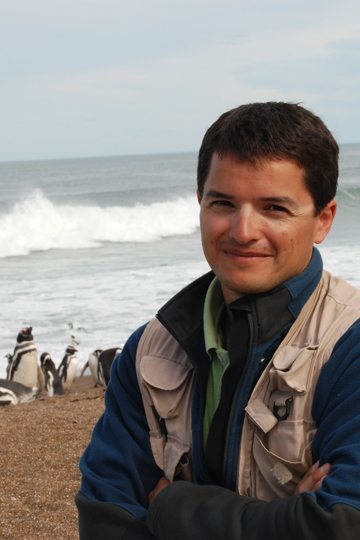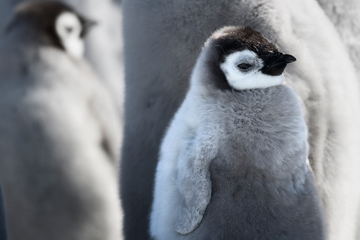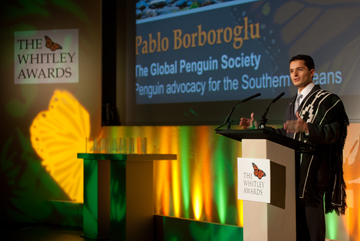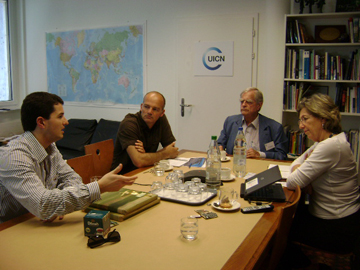
Photo Credit: ©Ron Naveen/Oceanites Inc. |
Chinstrap penguins at
Baily Head, Deception Island, off the Antarctic Peninsula. Researchers
have documented at least a 50 percent decline in the population over the
last 20 years. Various factors may be involved, but scientists don't
believe tourism is a contributing factor. |
By Peter Rejcek, Antarctic Sun Editor
Posted September 7, 2012
An iconic chinstrap penguin colony on Deception Island, a
popular stop for tourists to the Antarctic Peninsula, has declined by
more than 50 percent in the last 25 years.
That’s the conclusion published last month in the journal
Polar Biology
by a team of researchers that spent 12 days in December 2011 counting
individual penguin nests on the remote Antarctic island. The census
found nearly 80,000 breeding pairs, with about 50,000 at a location
called Baily Head.
The results were compared against a 1986-87 survey,
refined with a simulation designed to capture uncertainty in the earlier
population estimate by
British Antarctic Survey (BAS) 
scientists.
It had already been known that the colony was in steady
decline but no one had been able to quantify the plummet in population
until now.
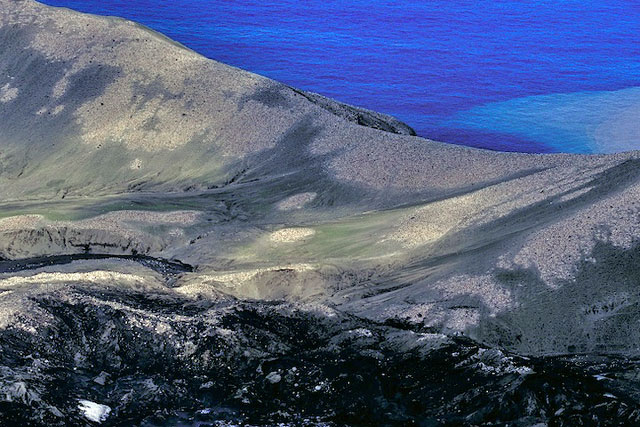
Photo Credit: ©Ron Naveen/Oceanites Inc.
An aerial view of chinstrap penguin colony at Baily Head, Deception Island.
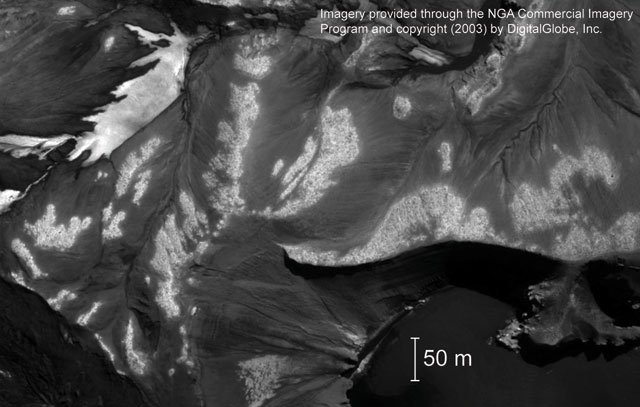
Photo Credit: ©DigitalGlobe Inc.; Image provided by National Geospatial-Intelligence Agency Commercial Imagery Program
A satellite image shows chinstrap penguin colonies at Baily Head, Deception Island, in 2003.
“It was really nice to be able to put a number on the
decline, since so many people were tossing around estimates that were
not based in data,” said
Heather Lynch 
, an assistant professor at
Stony Brook University 
and co-author on the paper. “Now we at least know exactly the status of
Deception, which is important both scientifically and for tourism.”
There has been concern by nations party to the
Antarctic Treaty System 
that the population crash at Baily Head was due largely to tourism.
During the 2010-11 season, 1,354 tourists visited Baily Head, a massive
amphitheater of breeding chinstrap penguins on the island’s eastern
shore. The common name for
Pygoscelis antarctica comes from the thin black line that runs around the penguin’s head.
However, the drop in the chinstrap population at Baily
Head is consistent with population declines of the species at other
locations, including sites that receive little or no tourism, according
to Ron Naveen, founder of
Oceanites Inc. 
,
a nonprofit organization that since 1994 has conducted the Antarctic
Site Inventory, an ongoing census of the seabird populations around the
Antarctic Peninsula.
Previously, the researchers had published results from
surveys of 29 chinstrap colonies that found significant declines at 16
sites and increases at only seven. Another one of the so-called
brushtailed penguins, Adélie numbers are also crashing along the
northwestern Antarctic Peninsula. The third brushtailed species,
gentoos, appears to be increasing in numbers. [See previous story —
The big picture: Broad-scale study suggests sea ice not driving changes in penguin populations.]
Pressures from climate change are believed to be hurting
the Adélie and chinstrap colonies off the Antarctic Peninsula, where
temperatures have increased by about 3 degrees Celsius in the summer and
almost double that in the winter. In particular, the Adélies rely on
sea ice as a key habitat. And while subantarctic chinstraps aren’t as
reliant on the seasonal pack ice, which is also shrinking in duration
and extent, food sources such as krill graze on the algae that grow
under the ice. Other factors may also be in play.
The team backed up its census data with a comparison of
satellite imagery between the 2002-2003 and 2009-2010 summer seasons.
During that seven-year period, the chinstrap population dropped by an
estimated 39 percent, though there was a larger degree of uncertainty
because of the difficulty involved in estimating nest density from the
satellite imagery.

Photo Credit: ©Ron Naveen/Oceanites Inc.
A chinstrap penguin at Baily Head, Deception Island.
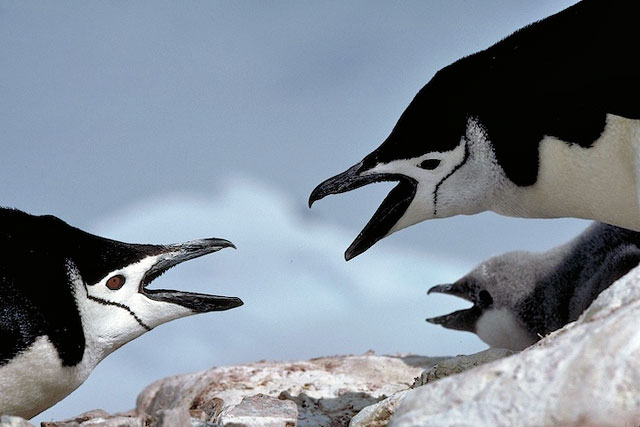
Photo Credit: ©Ron Naveen/Oceanites Inc.
Chinstrap penguin breeding pair with chick at Baily Head, Deception Island.

Photo Credit: ©Ron Naveen/Oceanites Inc.
Chinstrap penguins return to their nests from the small cove on the southwestern side of Baily Head, Deception Island.
“We do not yet have very sophisticated models for nesting
density, but we are working on them, and these will fit nicely into
everything we have developed to date and will allow us to shrink those
error bars substantially,” Lynch said.
Despite the uncertainty, there was a remarkable
correspondence between the field census and the satellite image counts,
according to Lynch.
“The two census estimates were completed entirely
independently using separate ‘pools’ of information,” she explained. “We
were completely shocked at how close the two census estimates were to
one another. I think this is a really incredible validation that the
high-resolution satellite imagery can produce census data of the same
quality as can be obtained in the field and, potentially, over a much
larger scale.”
Lynch is a proponent of remote-sensing conservation, a
growing field that uses satellite imagery to monitor wildlife
populations. The technique has been used in the Antarctic to assess seal
populations as well as penguin colonies. [See previous story —
Eyes in the sky: Scientists use satellites to track health of seal, penguin populations in Antarctica.] She is also an advisory member of the
Polar Geospatial Center (PGC) 
, based at the
University of Minnesota 
. PGC has access, through the
National Geospatial-Intelligence Agency 
, to high-resolution commercial satellite imagery.
Fortunately, for seasoned and enthusiastic field hands
like Naveen, there’s still a need to visit and census the animals on the
ground.
“The reason that we were able to use the satellite
imagery so successfully is because we have a lot of ground truthing data
— density estimates, photo-documentation, personal experience — and as
we start expanding this approach, our investment in regional-scale
census work is going to pay major dividends,” Lynch said.
Of course, the fieldwork isn’t as romantic as it sounds.
The 12-day stint on Deception Island was as much a function of nasty
weather — persistent clouds, precipitation and at times gale-force winds
— as the desire to fill in a key gap in the Oceanites dataset,
according to Naveen.
“Deception [has] never been fully censused in one season,
let alone 12 days. Unfortunately, the weather was such that we never
left Deception,” he said. “I wanted to make sure we had those data in
hand and this coming season we’ll be doing more ‘gap’-filling work.”
In 18 years, Oceanites teams have conducted more than
1,200 census visits at 169 locations over an area covering more than
100,000 square kilometers. Naveen said he is eager to continue the
census work, especially with the more sophisticated analytical tools
employed by Lynch and her lab.
“Assessing and analyzing the changes now occurring in the
peninsula is an engrossing and thoroughly complex undertaking,” he
said. “The statistics and photo-analytical resources we have available,
and the new ones that we’re developing, particularly in regard to using
satellite photo-documentation … will give all of us a better
understanding of what’s driving change in the vastly warming peninsula
ecosystem.”
source


 Dr
Cannell notes that one of the most important findings of the study was
of the correlation between higher sea surface temperatures around April
and reduced breeding performance. Image: WhatsallthisthenA RECENT study has found links between environmental conditions and breeding performance in a colony of Little Penguins (Eudyptula minor) near Rockingham.
Dr
Cannell notes that one of the most important findings of the study was
of the correlation between higher sea surface temperatures around April
and reduced breeding performance. Image: WhatsallthisthenA RECENT study has found links between environmental conditions and breeding performance in a colony of Little Penguins (Eudyptula minor) near Rockingham.










 What a difference a year makes. Last November, two male African penguins (Spheniscus demersus)
living at the Toronto Zoo made worldwide headlines after they took more
interest in each other than in members of the opposite sex.
What a difference a year makes. Last November, two male African penguins (Spheniscus demersus)
living at the Toronto Zoo made worldwide headlines after they took more
interest in each other than in members of the opposite sex.
















